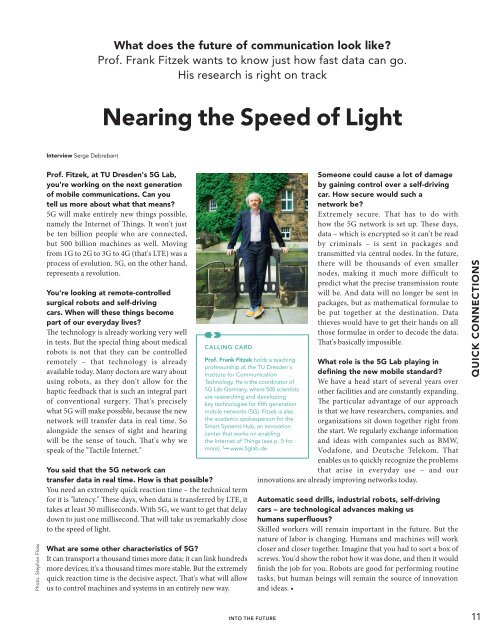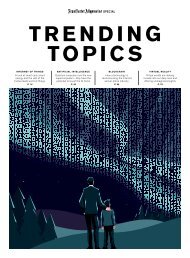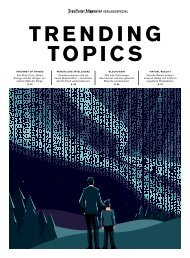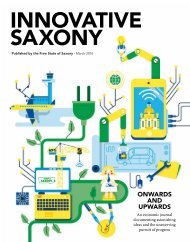Innovative Saxony
Into the future! A magazine of remarkable ideas and valuable networks
Into the future! A magazine of remarkable ideas and valuable networks
You also want an ePaper? Increase the reach of your titles
YUMPU automatically turns print PDFs into web optimized ePapers that Google loves.
What does the future of communication look like?<br />
Prof. Frank Fitzek wants to know just how fast data can go.<br />
His research is right on track<br />
Nearing the Speed of Light<br />
Interview Serge Debrebant<br />
Photo: Stephan Floss<br />
Prof. Fitzek, at TU Dresden's 5G Lab,<br />
you're working on the next generation<br />
of mobile communications. Can you<br />
tell us more about what that means?<br />
5G will make entirely new things possible,<br />
namely the Internet of Things. It won't just<br />
be ten billion people who are connected,<br />
but 500 billion machines as well. Moving<br />
from 1G to 2G to 3G to 4G (that's LTE) was a<br />
process of evolution. 5G, on the other hand,<br />
represents a revolution.<br />
You're looking at remote-controlled<br />
surgical robots and self-driving<br />
cars. When will these things become<br />
part of our everyday lives?<br />
The technology is already working very well<br />
in tests. But the special thing about medical<br />
robots is not that they can be controlled<br />
remotely – that technology is already<br />
available today. Many doctors are wary about<br />
using robots, as they don't allow for the<br />
haptic feedback that is such an integral part<br />
of conventional surgery. That's precisely<br />
what 5G will make possible, because the new<br />
network will transfer data in real time. So<br />
alongside the senses of sight and hearing<br />
will be the sense of touch. That's why we<br />
speak of the "Tactile Internet."<br />
CALLING CARD<br />
You said that the 5G network can<br />
transfer data in real time. How is that possible?<br />
You need an extremely quick reaction time – the technical term<br />
for it is "latency." These days, when data is transferred by LTE, it<br />
takes at least 30 milliseconds. With 5G, we want to get that delay<br />
down to just one millisecond. That will take us remarkably close<br />
to the speed of light.<br />
What are some other characteristics of 5G?<br />
It can transport a thousand times more data; it can link hundreds<br />
more devices; it's a thousand times more stable. But the extremely<br />
quick reaction time is the decisive aspect. That's what will allow<br />
us to control machines and systems in an entirely new way.<br />
Prof. Frank Fitzek holds a teaching<br />
professorship at the TU Dresden's<br />
Institute for Communication<br />
Technology. He is the coordinator of<br />
5G Lab Germany, where 500 scientists<br />
are researching and developing<br />
key technologies for fifth generation<br />
mobile networks (5G). Fitzek is also<br />
the academic spokesperson for the<br />
Smart Systems Hub, an innovation<br />
center that works on enabling<br />
the Internet of Things (see p. 5 for<br />
more). www.5glab.de<br />
Someone could cause a lot of damage<br />
by gaining control over a self-driving<br />
car. How secure would such a<br />
network be?<br />
Extremely secure. That has to do with<br />
how the 5G network is set up. These days,<br />
data – which is encrypted so it can't be read<br />
by criminals – is sent in packages and<br />
transmitted via central nodes. In the future,<br />
there will be thousands of even smaller<br />
nodes, making it much more difficult to<br />
predict what the precise transmission route<br />
will be. And data will no longer be sent in<br />
packages, but as mathematical formulae to<br />
be put together at the destination. Data<br />
thieves would have to get their hands on all<br />
those formulae in order to decode the data.<br />
That's basically impossible.<br />
What role is the 5G Lab playing in<br />
defining the new mobile standard?<br />
We have a head start of several years over<br />
other facilities and are constantly expanding.<br />
The particular advantage of our approach<br />
is that we have researchers, companies, and<br />
organizations sit down together right from<br />
the start. We regularly exchange information<br />
and ideas with companies such as BMW,<br />
Vodafone, and Deutsche Telekom. That<br />
enables us to quickly recognize the problems<br />
that arise in everyday use – and our<br />
innovations are already improving networks today.<br />
Automatic seed drills, industrial robots, self-driving<br />
cars – are technological advances making us<br />
humans superfluous?<br />
Skilled workers will remain important in the future. But the<br />
nature of labor is changing. Humans and machines will work<br />
closer and closer together. Imagine that you had to sort a box of<br />
screws. You'd show the robot how it was done, and then it would<br />
finish the job for you. Robots are good for performing routine<br />
tasks, but human beings will remain the source of innovation<br />
and ideas. •<br />
QUICK CONNECTIONS<br />
INTO THE FUTURE<br />
11
















